Marketing Strategies
What Shifts in Product Demand Mean for SEO
Posted by SabrinaBomberger
If you’re working in e-commerce through the COVID-19 crisis, you’ve likely noticed some wild shifts in the way your products are viewed and consumed by the public. After all, the needs of the entire world have changed in some capacity. It makes sense that purchasing habits have, too.
This shift in demand might require an equal shift in your marketing strategy. As an SEO, you need to make sure that you understand the new demands on your product in the given market, and ensure any on-site changes are SEO-friendly.
These strategies apply not only in the midst of our current pandemic, but also during any rapid or unexpected change in product demand.
E-commerce sites are facing two very different scenarios
With my own e-commerce clients, and as a consumer myself, I’ve noticed two ways that the COVID-19 outbreak is affecting product demand:
1. Your product is suddenly a hot commodity and demand has skyrocketed.
Sporting goods, home office supplies, and backyard furniture have all exploded since social distancing guidelines were imposed.
Roller skates, for example, are having a moment. Lots of people (including me!) have turned to skating and other outdoor activities for recreation. And with many brick-and-mortar stores closed, we’re buying these items online.
[Alt text: Google Trends chart for the keyword “roller skates”, which shows relatively steady numbers until a sharp increase in March 2020]
2. Your product is suddenly less relevant to the market and demand has drastically decreased.
Items like apparel, shoes, and luxury goods are all experiencing this to a degree. Engagement rings — being expensive and tied to a major life event — saw a sharp decrease in search volume in March 2020.

[Alt text: Google Trends chart for the keyword “engagement rings”, which sees relatively steady numbers until a sharp decrease in March 2020.]
These examples fall on opposite ends of a demand spectrum. Take time to analyze your traffic and consider which side of the spectrum your product lands on, so you can make the best of your situation as an SEO and marketer.
If your product is more in demand than ever
You may think it’s all positive when your product is in a season of high demand, especially during an economic downturn. But an unexpected uptick in demand can cause a host of marketing and SEO challenges to contend with. Here are some of the most important considerations to take into account if your products are newly booming.
Manage temporary out-of-stock products
Disrupted supply chains paired with a demand increase is a recipe for an out-of-stock disaster, at least temporarily. If this isn’t something your site typically deals with, you may be the one who has to figure out what to do with these product pages while you wait for a restock.
Dr. Pete has a fantastic article about the best way to handle temporary out-of-stock that you should check out if this is your scenario.
Spoiler alert: please don’t 404 these pages if the product will be restocked. Also, make sure that you’re providing helpful information about where users can find the product in stores, or how they can be notified when it’s back in stock online.
Address common user questions
Given the extreme circumstances we’re collectively experiencing, customers need to be reassured about any contingencies they’ll face when ordering your product. It is critically important to address these pain points with on-site messaging during a sudden uptick in order volume for two reasons:
- You are likely unprepared for a massive influx of customer service calls. Even if you are prepared, you should do what you can to spare your customer service reps!
- Many customers don’t want to reach out to customer service to get a basic question answered. If they can’t find the information quickly on your site, they’re more likely to find another site to take their money.
If you don’t know what your customers are asking about, there are a few ways to find out:
- Talk to your customer service reps. They speak with your customers every day, and likely have answered the same questions over and over again. These are the questions to address on-site.
- Mine your chat logs for repeat questions.
- See what customers are asking about on social media — check your linked and unlinked mentions!
- Address anything you know to be a current concern: are there shipping delays? Back ups with your warehouse? Let people know about it up front to save yourself from angry customer messages later.
You can respond to these questions in several different ways on your site. Adding banners, pop-ups, and even prominently displaying your FAQ page are all options. Just make sure your message is easy to find without detracting from important product details.
Moxi Skates provides a great example of this strategy in action. On every product page, they include a “COVID Questions” tab to address changes in operations due to the pandemic. They also have a message directly under the “Add to Cart” button telling users how long they can expect to wait for their skates.
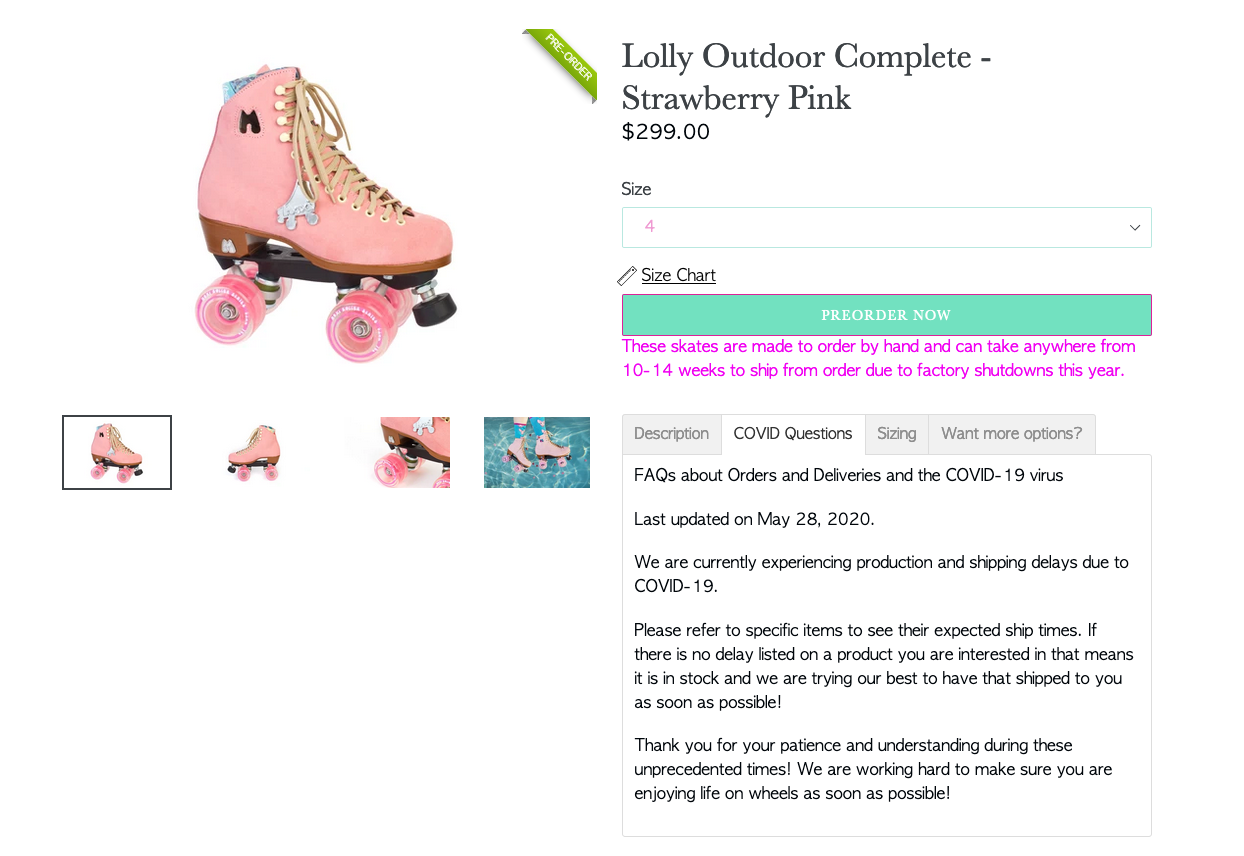
[Alt text: A product page from Moxi Skates that includes a “COVID Questions” tab, describing what customers need to know about the current shipping status of the product.]
Meet your users where they are
If your product is suddenly popular because of a lifestyle change for your customer (such as working from a home office instead of in-office), you could test new language and imagery to keep your products relevant in their new setting.
Vari makes desks and other office furniture, including popular standing desks. Before the pandemic, their homepage featured only in-office business imagery. Now, they prominently feature desk solutions for home learning and work-from-home. This didn’t replace their office-focused messaging, but supplemented it in a useful way.
Notice there’s no overdone “in these trying times” or “now more than ever” language. Rather they’re speaking directly to this newly popular use for their product.
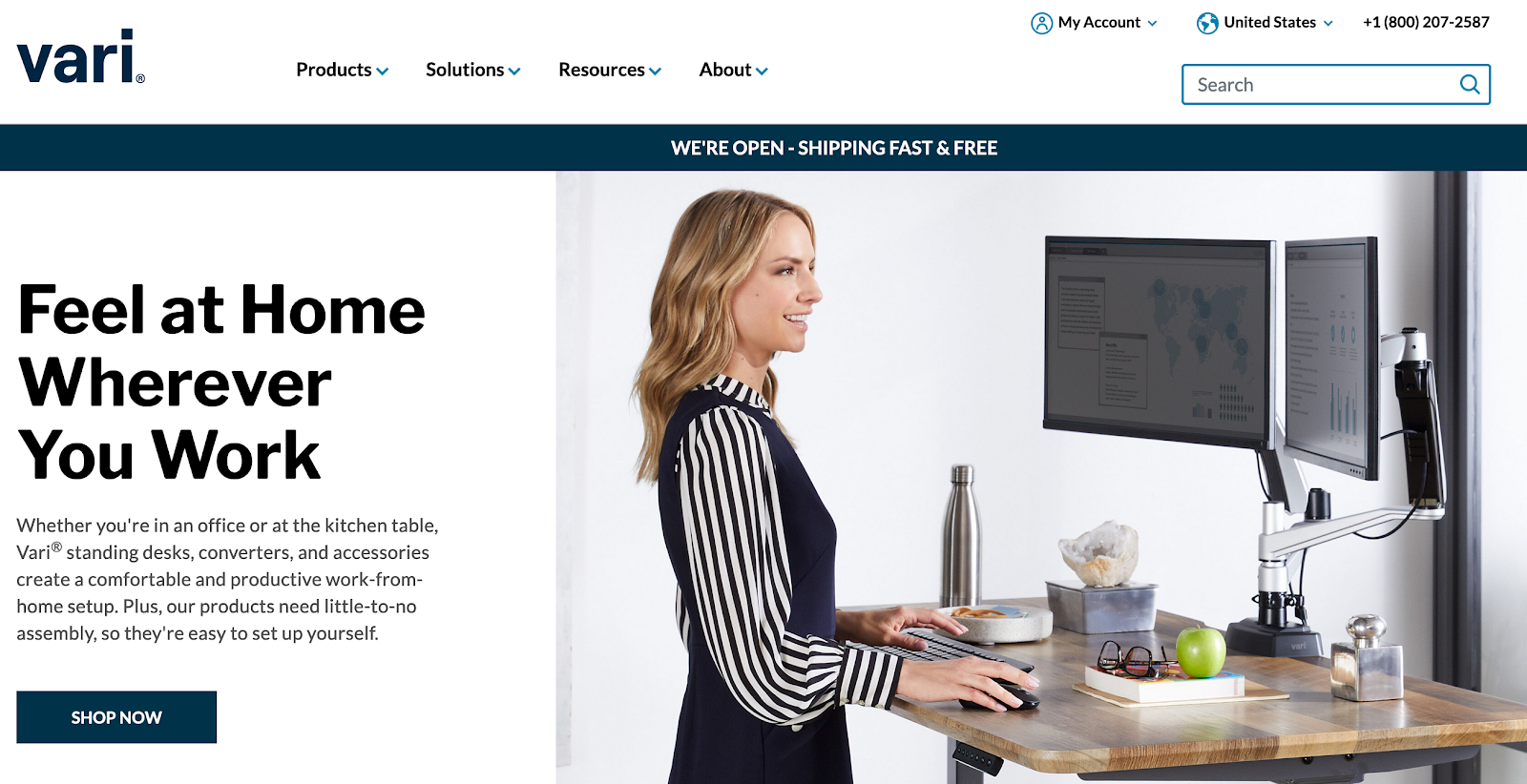
[Alt text: A screen shot from Vari’s homepage that pictures a woman working at a desk. The main text says “Feel at Home Wherever You Work.”]
Find opportunities to create new indexed pages
With the advent of new concepts comes the opportunity for new indexed pages — both on the content and product side.
Five months ago, “social distance supplies” had no monthly search volume, and likely didn’t mean much to any of us. Yet now it’s the language we use to describe products like hand sanitizer, cleaning wipes, masks, and gloves.
Sure you could call those items “safety supplies”, “cleaning supplies”, or “PPE”, and you might still want to do that, but there’s a new opportunity to use “social distancing supplies” as another relevant semantic grouping that may capture additional search traffic.
Concepts like this can be slow to show promise in keyword research tools, but it’s important as SEOs to be on top of the language users are actually using to refer to new concepts related to our products.
Here are a few ways to spot trends before keyword research tools do:
- Monitor internal site search for any novel concepts or terms.
- Spend time where your users do — are they in parent groups on Facebook talking about pandemic pods and distance learning? If so, they were likely there discussing these concepts before they were trending in search tools.
- Stay connected to the news and watch for anything that might be relevant to your products.
This “At-Home Learning” category page from Target pulls together products including desks and chairs, art supplies, computers, and more in one indexed page, providing a one-stop-shop for new homeschooling parents. At the time of this writing, this page is ranking in position six for the “at home learning” keyword in the United States, which is quite impressive for an e-commerce page in an information-dominated SERP.
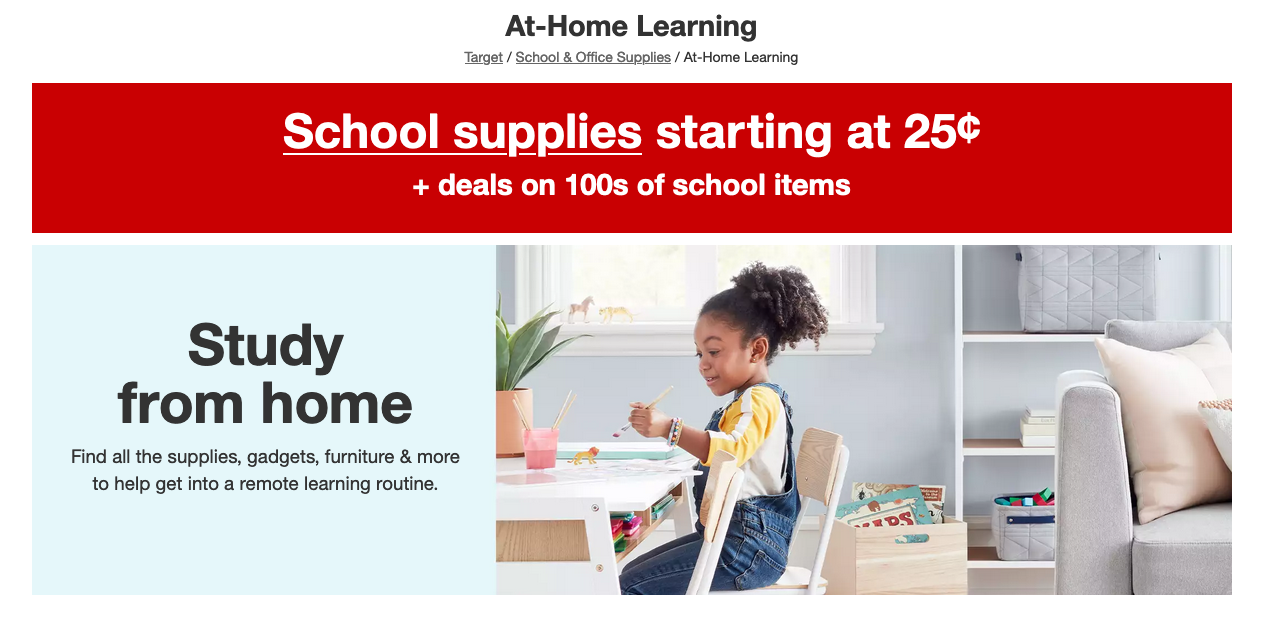
[Alt text: A screenshot of Target’s At-Home Learning category. The main text says “Study from home - Find all the supplies, gadgets, furniture & more to help get into a remote learning routine.”]
If your product demand has suddenly decreased
Now we need to talk about the other side of the coin — what if demand for your product has drastically decreased?
Luxury goods, apparel, and anything that includes a “try in-store, buy online” model are struggling.
If you work in marketing at an e-commerce site that’s suffering through the COVID-19 crisis, it may feel like there’s nothing you can do. While you can’t change the market, there are still practical ways you can help your company make the most of the situation.
Highlight your most relevant products
Although some clothing retailers are struggling, many of them have leaned into the stay-at-home situation by creating a loungewear category and prominently featuring it in their marketing. Though loungewear isn’t the primary focus for many of these businesses, nor the most expensive clothing category, it’s more likely to be purchased while customers are staying at home.
Check out Google Trends for “loungewear” — you can see why retailers have heavily promoted this category for the last several months.
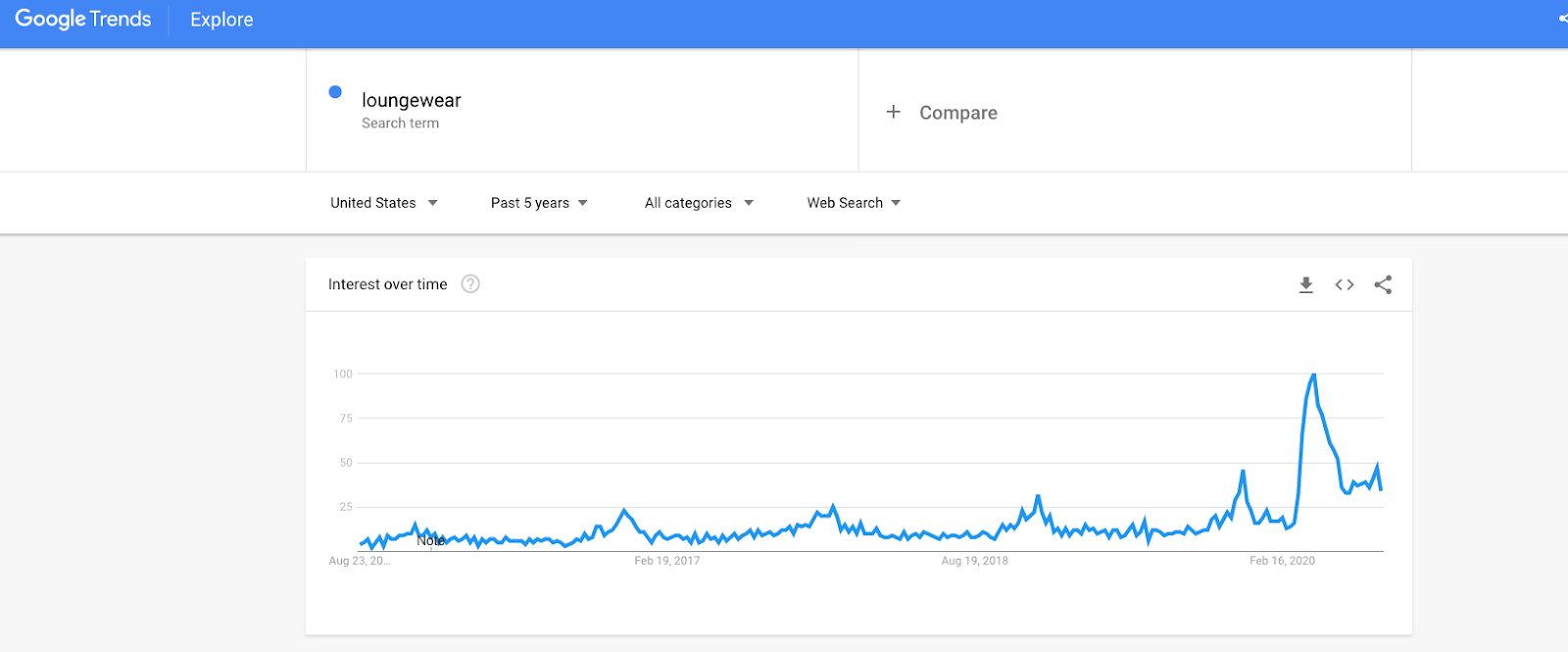
[Alt text: Google Trends chart of the keyword “loungewear,” which shows relatively steady numbers until a sharp increase in March 2020.]
Even if you’re not in the apparel business, you can employ this strategy by scanning your product catalog for any lesser-promoted products that could be more relevant in the current climate.
If you can’t find any, consider tweaking your messaging.
Craft messaging for the moment
If your typical brand messaging no longer makes sense given the change in your customers’ lifestyles, you need to update the language you’re using to communicate with them. It doesn’t do your users any good to pretend that we’re not in the middle of a pandemic.
Right now, messaging like “Look good for summer concerts, vacays, and nights out!” just makes me sad. Don’t remind your users that they can’t do those things right now.
Again, your messaging doesn’t have to be doom and gloom, but make sure it fits: “Look good for backyard hangouts, virtual happy hours, and Sunday drives!” is much more appropriate, and positions your product as relevant even in an upside-down world.
Replace in-person experiences with virtual try-ons
Businesses that employ a “try in-person, buy online” model are facing a unique challenge. How do you encourage customers to purchase something, like an engagement ring, without seeing it first in person? Though some users are growing more comfortable with a fully online experience, others still prefer to interact with a salesperson or stylist for this type of purchase.
Creating a virtual try-on experience can be useful in at least partially replacing that in-person component, and can be achieved with dedicated customer service and/or development resources.
Anna Sheffield, a fine jewelry designer, offers live virtual appointments that are prominently featured on their site. This service offers customers a personal touch, and gets them connected with a brand representative who can help encourage a confident purchase without leaving the house.

[Alt text: A screenshot of Anna Sheffield’s virtual appointment information, detailing how users can set up a consultation with a stylist.]
Brilliant Earth, another company that sells wedding rings, uses a tool that allows users to virtually try on rings from home. No additional customer service time required.

[Alt text: A screenshot of Brilliant Earth’s instructions for how to use their virtual engagement ring try on tool.]
Offer buy-now-pay-later
E-commerce sites have more options than ever to extend payment plans to their customers. Afterpay, Affirm, and Klarna are all popular extensions that allow you to offer credit to your customers easily and securely.
For users feeling nervous about buying something that they don’t strictly need during a recession, this could be the difference that causes them to convert.
Summing it up
Change in consumer demand is a challenge that all businesses face, and now more than ever (see what I did there), it’s important for e-commerce SEOs to be responsive to these changes. Although none of us could have predicted what 2020 had in store, we can assess how the market has responded to our products and act accordingly.
What pivots have you or your clients made in e-commerce business models this year? Let me know in the comments!
Sign up for The Moz Top 10, a semimonthly mailer updating you on the top ten hottest pieces of SEO news, tips, and rad links uncovered by the Moz team. Think of it as your exclusive digest of stuff you don’t have time to hunt down but want to read!
Marketing Strategies
How to Craft the Story for Your Holiday Marketing Strategy
On August 25th, nearly a month before the official first day of the new season, Starbucks declared it fall.
It didn’t matter that it was still reaching record high temperatures; it didn’t matter that leaves wouldn’t start falling for weeks or even months; it didn’t matter that the corn mazes were still only knee high.
All that mattered was that Starbucks fans wanted it to be fall. They desperately wanted an escape from the hellish summer than most of us have been experiencing.
So Starbucks crafted the perfect autumnal alternate universe, where you could wear a scarf and look at the leaves and drink a PSL without sweating through your facemask.
And if you think that campaign was met with a raised eyebrow and a glance at the calendar, then you clearly underestimate the power of telling your customers the story they want to hear.
See, good marketing sells the transformation, rather than the product itself. You frame it as the solution to a problem. Before, things were bad. But now that you have this or have done that, your after state is wayyy better.
But if you want really good marketing—like the marketing that has pumpkin cream cold brew coffees sold out every time I try to buy one—you’ll need to craft that transformation into a story.
Humans connect to emotion and narrative, so if you set up your marketing to tell a story, especially a story that your customers want to see themselves in, you’ll find yourself raking in the pumpkin spice… er… I mean the sales.
This is particularly important around the holiday season, when anyone and everyone is trying to sneak into the wallets of your customers. Your best chance at being one of the lucky few is to strengthen the bond with your customers. Build a connection through storytelling.
If you are still unsure about how to create a story around your product, we’re here to help. We’ve broken this process down into 3 steps and have some examples you can pull inspiration from throughout.
(And if the smell of pumpkin spice in the air is starting to give you the holiday promotion stress sweats, just download our FREE 2020 Holiday Marketing Preparedness Plan.
We’ve mapped out when you should start preparing for the major holidays through the end of 2020, exactly what you will need, when you should have everything ready to go, and even when you should start your promotions.)
Figure Out What Your Customers Want
The first step to creating a great story around your product or service is to know what your customers want. What story do they want to see themselves in?
The best way to figure this out is by turning to your trusty Customer Avatar Worksheet, you know, that thing that defines exactly who your ideal customer is?
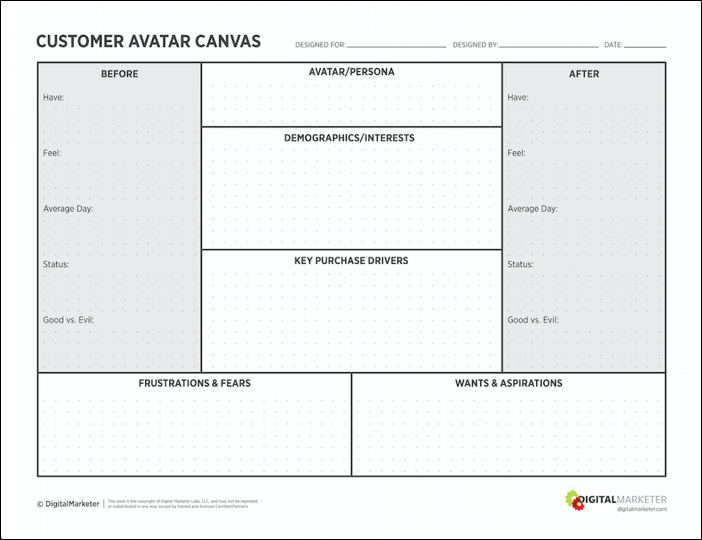
If you’ve filled out your CAW, you’ll know exactly what your customers want and are interested in, what they are afraid of and frustrated with, and what kinds of media they consume.
And if you’ve filled out the Before and After grid, shown above alongside the CAW, you know how your customers are feeling before becoming a customer and how they should feel after buying your product or service.
With all of these resources, and a good working knowledge of your ideal customer, you should be able to easily craft a story that shows the transformation.
If we look to Starbucks as an example, they knew just how much their customers wanted it to be Fall. They understood the frustration with the hot weather or the fear of the current social chaos.
So they created a story about falling into the new season (the pun was just a happy coincidence), and targeted their marketing efforts into creating a relaxing, enjoyable fall experience.

And their biggest marketing push (aside from the drinks themselves) was for the fall hotline they created.
Customers could call in and hear the sounds of fall, long before the actual season hit them. Not only did this hit on the exact pain point, but it crafted a narrative around the transformation.

They knew exactly what their customers wanted, and delivered it in their marketing efforts.
Decide How Your Product or Service Fits In
Once you know what your customer wants, your next step is to decide how your product will fit in.
With some holidays, you might be providing a great gift that will charm and impress their loved ones.
Or, if you are like David’s Tea (in a similar way to Starbucks), you might be providing a comforting environment and a joyful experience.
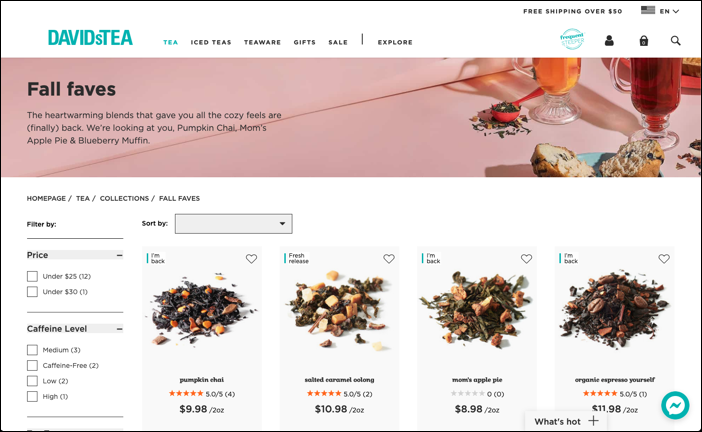
However your product fits in, make sure to keep that action as a central point in your marketing story, and keep it as consistent as possible across all platforms and content.
You can see how David’s Tea used the same language, “this heartwarming blend will give you all the cozy feels” on both their product page and their Facebook ad.

Keeping your story the same on different platforms not only means you are sure to reach all your customers, but it helps solidify the emotional response your customer will have.
For David’s Tea, any potential customers who saw the ad and thought, “ohh I need some coziness in my life,” they don’t get jarred by a different message when they hit the landing page.
Craft a Story Where Your Customer is the Main Character
The central idea of creating a marketing “story” is that your customer is the star. You want the messaging to center around the customer and how they will feel and change rather than your product.
You can see here with this BarkBox copy, they have gone even further with their story than the other examples, going so far as to cast their customers’ dog (arguably the real customer, though maybe not the one with final buying power), into a story about a lovely fall drive.
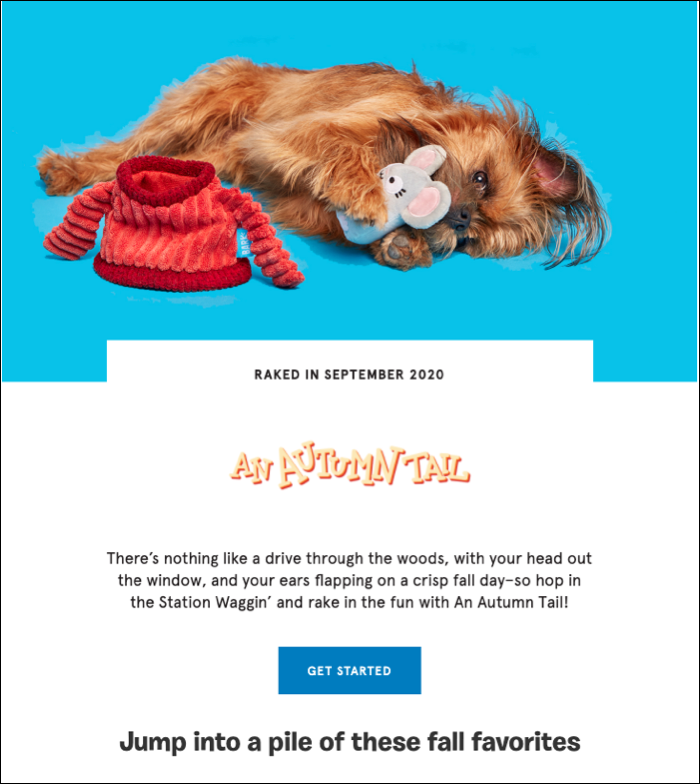
Anyone with a dog (and a heart) will immediately be drawn into the story and see themselves and their furry best friend in this car ride.
And then when they read through the rest of the product description, they are still within that relaxed, happy emotional state, and are drawn closer to the products by extension.

Plus, who wouldn’t be charmed by a sweater wearing mouse?
No matter what your story is, make sure you are making your customer the main character. Cast them as the star, and they will make a better connection to your brand and the product you are targeting them with.
By crafting an emotionally driven story that hits on the desires of your audience, you’ll be sure to cut through the noise of the season and solidify your customers’ love for you and your brand.
And if you want to feel better prepared to put your holiday marketing story into action, download our 2020 Holiday Marketing Preparedness Plan.
After all, what is a better gift this holiday season than having a handle on your marketing campaign before the season even starts? Well, maybe a PSL… but that could just be me.
The post How to Craft the Story for Your Holiday Marketing Strategy appeared first on DigitalMarketer.
Marketing Strategies
Marketing and Selling Procurement Software Products and Services
Procurement software is the automation of the procurement process across a web-based system which allows buyers and sellers to locate each other quickly and submit relevant bids for products and services.
By implementing reliable procurement software or services, it enables a company to stabilize the process of obtaining necessary materials and services at quite affordable rates. Of course, besides the obvious financial advantages, procurement software/service also helps a company to have sustainable economic growth.
Today, we’re going to talk about the ways you can effectively sell your procurement software/services.
To start it off, let’s look at the key benefits of having good procurement.
Improved Spend Visibility
All transaction details are stored and monitored regularly. It gives complete details about the passage of the money regarding the cost, suppliers, and quality and time of delivery of the products, etc.
Cost Savings
A procurement system analyzes the areas where high and low costs are required in acquiring things, which services are purchased regularly, places where the company can save costs, and suppliers who provide the best quality products at lower costs.
Minimizes time and errors
Procurement software works in an automated or semi-automated way thus eliminating the errors and time consumption by manual labor.
Improved Supplier relationships
The suppliers are highly competitive. That puts the company at the liberty of choosing the best suppliers and negotiating the terms based on the company’s demands, concerns, and constraints.
The main reason why we kicked off with the key benefits of procurement software/service is that you need to be able to make your customers understand why it’s important and how it can specifically help their business when you do your sales pitch.
Before you market your software/service, make sure that you know exactly who your key target is going to be. In this case, your key target would be the CFO as his or her imperatives such as margin, risk/controllership, cash flow are directly linked to the CPO and procurement organization of their company.
The typical resistance you will face especially when selling your procurement services is the concern of taking over people’s jobs. So to shed light on this concern, you have to let your customers know that procurement isn’t about eliminating jobs, rather it’s about creating bandwidth for the procurement organization so they can focus on more specific activities all while you, their partner, can focus on driving value on the transactional or fragmented activities.
Another key element of selling this service is to develop a compelling commercial model that shares the risk of the endeavor.
When you finally arrange a meeting with the decision-makers, plan your key points the same way you plan your discussions with marketing directors. Think through the procurement executive’s role and mindset, and make sure that your compensation discussions recognize procurement’s needs and hot buttons.
It may be tricky and it definitely has its hurdles when selling your procurement software/services, but just remember to not over complicate things. Be straightforward but coherent and most importantly, offer solutions rather than just trying to sell your product/service.
This article originally posted at The Savy Marketer.
Marketing Strategies
Dancing with belief
All of us believe things that might be inconsistent, not based on how the real world actually works or not shared by others. That’s what makes us human.
There are some questions we can ask ourselves about our beliefs that might help us create the change we seek:
Is it working?
If your belief is working for you, if it’s helping you navigate a crazy world and find solace, and if it’s not hurting anyone else, it’s doing what it’s supposed to do. Often, beliefs are about finding human connection and a way to tell ourselves about our place in the world, not as an accurate predictive insight as to what’s actually happening. And beliefs are almost always about community, about being part of something.
Is it helpful?
Air traffic controllers and meteorologists rarely believe that the earth is flat. It’s a belief that would get in the way of being competent at their work. If your beliefs are getting in the way of your work, of your health or the health of those around you, or of your ability to be a contributing citizen, it might be worth examining why you have them and how they got there. Did you decide to have these beliefs or did someone with an agenda that doesn’t match yours promote them?
Is it true?
True in the sense that it’s falsifiable, verifiable, testable and predictive. Falsifiable means that the belief is specific enough that something contrary to the belief could be discovered (“there are no orange swans” is a falsifiable belief, because all we need to do is find one orange swan). It’s not necessary for a belief to be scientifically true, in fact, it undermines the very nature of belief to require evidence. Once there’s evidence, then whatever is true is true, whether or not you believe it.
Do you need it to be true?
Which means that much of what we do to somehow prove our beliefs are true is wasted time and effort. If a belief is helping you make your way through the world, if it acts as a placebo and a balm and a rubric, then that’s sufficient. The problems occur when some people use our beliefs to manipulate us, when they prevent us from accomplishing our goals or contributing to the well being of those around us.
What would change your mind?
If we decide that our belief is actually true, we owe it to ourselves to be clear about what would have to happen for us to realize that it’s not. One of the frustrating things about conspiracies and modern memes is that as soon as they’re examined or contradicted, they’re simply replaced with a new variation. It’s one thing to change beliefs because the scientific method shows us a more clear view of what’s happening, it’s totally different to retreat to ever more unrelated stories in the face of reality. Sometimes, it’s easier for people to amend their belief with one more layer of insulation than it is to acknowledge how the world is likely to work.
-
 Business2 months ago
Business2 months agoBernice King, Ava DuVernay reflect on the legacy of John Lewis
-
World News2 months ago
Heavy rain threatens flood-weary Japan, Korean Peninsula
-
 Technology2 months ago
Technology2 months agoEverything New On Netflix This Weekend: July 25, 2020
-
Finance4 months ago
Will Equal Weighted Index Funds Outperform Their Benchmark Indexes?
-
Marketing Strategies9 months ago
Top 20 Workers’ Compensation Law Blogs & Websites To Follow in 2020
-
 World News8 months ago
World News8 months agoThe West Blames the Wuhan Coronavirus on China’s Love of Eating Wild Animals. The Truth Is More Complex
-
Economy11 months ago
Newsletter: Jobs, Consumers and Wages
-
 Finance9 months ago
Finance9 months ago$95 Grocery Budget + Weekly Menu Plan for 8


